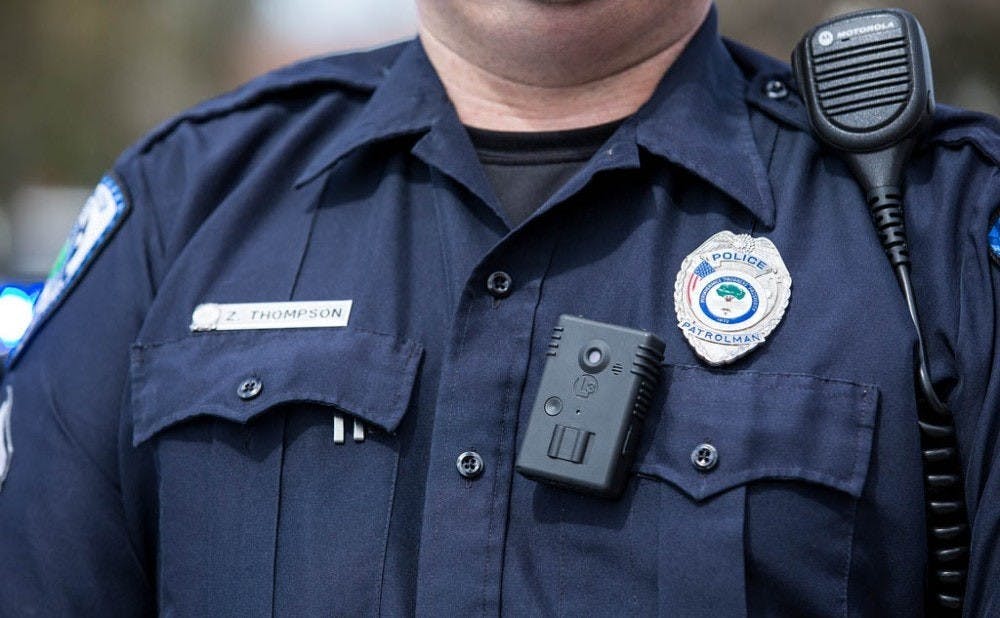Before attending Duke, I went to Missouri public schools all my life. Though my adolescent experiences have varied pretty substantially from some of my Duke peers who attended the finest Academies and Institutes, I’ve recently been reflecting on one mundane memory.
During my sophomore year of high school, I was sentenced to lunch detention for repeatedly being late to AP Calculus. I dutifully sat through my half hour of boredom and self-reflection as a police officer in full uniform and gear watched over me. I found it hilarious that the school thought my threat of lunchroom disruption was fit for grade-A law enforcement. This was just one of many mundane interactions with our School Resource Officers, who were assigned to watch over our school as their beat. They routinely handled disciplinary issues and even came to our classrooms for educational purposes.
Yet this mundane image of law enforcement handling routine student discipline has deeply problematic implications. After working on the American Civil Liberties Union’s School-to-Prison Pipeline Project, I grew to understand some of my experiences in context of a growing national trend: zero-tolerance discipline and an explosion police in schools have created a school-to-prison pipeline.
When schools overuse police, the lines between school discipline and law enforcement blur. As students are criminalized, they can be ticketed hundreds of dollars just for being late or arrested for talking back to teachers. Students have been tasered and beaten by police for ‘defiance.’ And this kind of discipline disproportionately targets students of color and students with disabilities. We’ve all seen the video of the black girl getting thrown out of her desk and dragged across the floor for refusing to give up her cellphone.
Police are put in schools under the premise of safety. But we should make policies based on evidence, rather than assumptions. Studies show there is no evidence police officers make schools safer, no evidence that they prevent mass shootings and ample evidence that police presence can make schools more hostile environments for all students.
And recently, police presence in schools has posed a particular threat to immigrant students. Racial profiling and unaccountable policing in many schools have created a school-to-deportation pipeline.
Anytime a student is arrested, a record is created, which can lead to a child’s fingerprints being taken and entered into a database that ICE can access. ICE can issue immigration detainers and assume custody of students. Students sent into juvenile detention from school-arrest can in some states be referred by probation departments to ICE for possible detainment. An arrest on a record can even compromise the lawful immigration status of certain students.
Even when a student is not arrested, school police can issue citations for minor incidents, which also creates a court-system record. These records can show up on background checks and employment inquiries, further complicating the maintenance or acquisition of immigration status.
Many schools use officers from local police departments who may also have working agreements with ICE. We’ve seen several disturbing incidents where Latino students have been falsely accused of ‘gang involvement’ and sent to ICE for deportation.
Under the Obama Administration, the U.S. Department of Homeland Security adopted the policy of limiting arrests in ”sensitive locations” such as schools, hospitals, and churches. The Department of Education has acknowledged that under the Supreme Court ruling Plyler v. Doe, “All children have a right to a free public education, regardless of their actual or perceived immigration or citizenship status or that of their parents.” School-based immigration enforcement is threatening that right.
As the Trump administration has been stepping up immigration sweeps, separating families, and detaining infants, Immigrations and Customs Enforcement (ICE) may very well be targeting public schools next. Ramped up immigration enforcement has taken place dangerously close to schools, leaving many students too afraid to go to class.
In May of 2018, Education Secretary DeVos testified before Congress that it is “a school’s decision” as to whether school staff can report students or families thought to be undocumented to ICE. A month later, she acknowledged that this is unlawful and flipped. Attorney General Sessions, speaking at a convention of over 1,000 School Resource Officers asserted a link between undocumented students and public safety, painting a picture of immigrant children who bring gangs and drugs into schools.
To be clear, this threat to students is not just a product of the current administration. The explosion of police presence in schools over the past 25 years that has created the school-to-prison pipeline laid the foundation for school-based deportation.
In our conversations about student safety, we must not lose sight of the bigger picture. Oftentimes after shootings, our gut reaction is to demand police in schools. It’s understood that many police officers have become involved in their schools and taken on counseling roles for students. But the evidence points to the fact that police don’t prevent shootings, and that the presence of even the most well-intentioned officers can have troubling collateral consequences for students.
So no, kids don’t need police officers to make sure they sit in lunch detention in silence. They don’t need zero tolerance and punitive punishment. They need restorative justice and supportive services that actually work to make them safer. They need counselors, teachers and principals. Not cops.
Lance Tran is a Trinity senior and a proud graduate of public schools. His column runs on alternate Tuesdays.
Get The Chronicle straight to your inbox
Sign up for our weekly newsletter. Cancel at any time.

